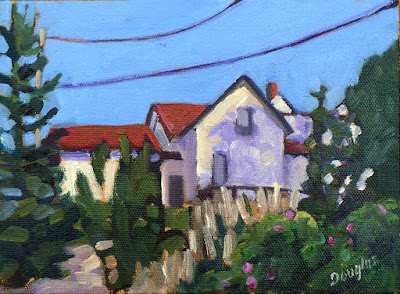Fences protect fools from the view. Unfortunately, they also separate the rest of us from it.
| Rocky, by Carol L. Douglas. |
Last summer I painted a rocky outcropping at Fort Williams for Cape Elizabeth Land Trust’s Paint for Preservation. It is a long finger of granite pointing straight into the ocean, as dramatic as any point at Acadia, but only minutes from downtown Portland. And therein lies the problem. People were constantly crawling out to the end of the rock to take selfies. I watched a couple encourage their kids to do it. The drop is easily long enough to kill, and the surf below will take what the rocks don’t.
The foolishness of all these visitors was manifest in their footwear, which ranged from flip-flops to sandals. In two-and-a-half days I saw only one properly-shod climber. He had a safety mat and was practicing some kind of technical descent.
 |
| Kaaterskill Falls, by Carol L. Douglas |
It reminded me of another popular tourist spot that’s also legendary among plein airpainters. That’s Kaaterskill Falls, a two-tier, 260-foot-tall waterfall in the Catskills. This was, in many ways, the heart of the Hudson River Schooland where plein air painting in America was born. When I first visited, it was easy enough to believe you were alone in the primeval wilderness. You approached the falls the same way as Thomas Cole, Frederic Edwin Church, and other great painters did, up a steep, 2.6-mile trail with very little in the way of safety improvements.
The last time I painted there was in 2014, with Jamie Williams Grossman and other friends from New York Plein Air Painters. It was shocking to see how many people crawled around the lip of the falls and its access trail wearing terrible footwear. That summer two visitors fell to their deaths. Access was closed for 2015 while they made safety upgrades. When it reopened the following summer, there was another fatality.
| The view of that rocky promontory is now obscured by a fence. (Photo courtesy of Karen Lybrand) |
Inevitably, the state of Maine had to fence off the rocky point I painted before someone falls to their death.
Artist Karen Lybrand walks at Cape Elizabeth almost every day, and sent me photos of the new fence. “I’m sure the risk-takers will still find a way to take selfies on the cliff rocks,” she commented. Someone will feel the need to get past the safety restrictions, resulting in more safety restrictions.
| You can see trail wear around the rocks. (Photo courtesy of Karen Lybrand.) |
Maine was projected to have around 40 million visitors in 2018. They’re not necessarily from places where people understand the risks of the natural world, or are expected to take responsibility for their own safety. Their attitude toward wilderness will inevitably affect our access to wilderness.
I’ve done that painting from exactly the low angle I wanted; I couldn’t paint it again, but I don’t want to, either. And it’s perfectly paintable from over the fence; it just won’t have the same looming presence.
 |
| A 1920s postcard showing the Marginal Way approaching Perkins Cove in Ogunquit. That was before the path was so heavily traveled. |
There are any number of coastal views that would be diminished with such a fence. They’re protected only by their isolation, and even that is slowly eroding as America’s population grows.
These are stunning views from places that are perfectly safe—until you stray from the path and do something stupid. But we can’t allow people to reap the consequences of their bad decisions in our litigious society, so they will be fenced off one by one.




